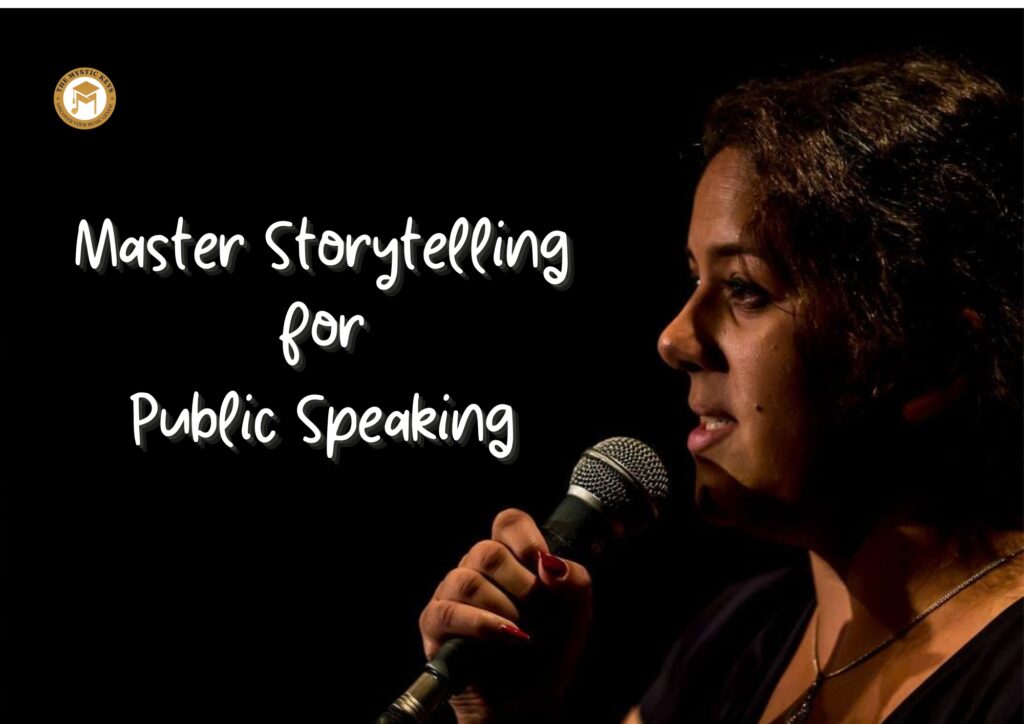Master Storytelling for Public Speaking | A Comprehensive Guide
Public speaking is an age-old skill that has shaped societies, moved hearts, and inspired action across centuries. Although facts, statistics, and data often form the backbone of many speeches, it is storytelling that truly touches the audience’s heart. In fact, storytelling serves as the secret ingredient that transforms ordinary speeches into powerful, memorable experiences. Therefore, mastering the art of storytelling in public speaking is not only about captivating your audience but also about communicating your message with greater clarity, deeper emotion, and lasting impact.
In the following detailed guide, we will first explore why storytelling holds such significance in public speaking. Next, we’ll break down the core elements that make stories truly compelling. Finally, we’ll provide actionable strategies to help you weave stories seamlessly into your speeches. Whether you’re just starting out or are already an experienced presenter, embracing the power of storytelling can undoubtedly elevate your public speaking prowess to an entirely new level.

Why Storytelling is Essential in Public Speaking
1. Human Connection
Humans are inherently wired for stories. From ancient times to the present day, storytelling has consistently served as the primary medium for transmitting knowledge, preserving culture, and conveying values. As a result, a well-told story does more than entertain—it fosters empathy, bridges cultural or emotional gaps, and makes the speaker more relatable. Moreover, unlike raw data or statistics, stories evoke genuine emotions, which in turn help the audience feel connected rather than detached.
2. Enhances Retention and Recall
Scientific studies show that stories significantly improve information retention by activating multiple areas of the brain. As a result, when an audience hears a story, they not only process the words but also begin to visualize scenes, experience emotions, and connect with the characters. Consequently, this multisensory engagement makes the information more relatable and, therefore, much easier to remember long after the speech has ended.
3. Simplifies Complex Ideas
Storytelling breaks down complex ideas into relatable, digestible parts. When you wrap your message in a story, abstract concepts become tangible. For example, sharing a real-life challenge and resolution can make a complicated business strategy more understandable.
4. Builds Credibility and Trust
Moreover, sharing personal stories or authentic examples significantly adds credibility. It not only shows vulnerability but also reflects honesty and transparency. As a result, audiences are more likely to trust and believe speakers who share real experiences, thereby enhancing both your influence and persuasive power.

The Core Elements of a Great Story in Public Speaking
Before diving into techniques, it’s essential to understand what makes a story resonate:
1. Clear Structure: Beginning, Middle, and End
Every great story has a clear structure:
Beginning: Set the scene and introduce the characters or context.
Middle: Present a conflict, challenge, or turning point.
End: Share a resolution or takeaway.
This structure guides your audience through the narrative journey and keeps them engaged.
2. Relatable Characters
Characters are the heart of your story. They can be yourself, a colleague, or even a metaphorical figure. The key is to make them relatable so your audience sees themselves in the story or empathizes with the character’s experience.
3. Conflict or Challenge
Conflict drives the narrative and creates tension. It could be a problem, dilemma, or obstacle that the character must overcome. This keeps your audience invested and curious about the outcome.
4. Emotional Connection
Effective stories evoke emotions—whether it’s joy, fear, hope, or sadness. Emotion is what makes your message impactful and memorable.
5. Meaningful Takeaway
Every story should have a clear purpose or lesson that ties back to your speech’s main message. This ensures your story reinforces your key points.

Practical Techniques to Master Storytelling in Public Speaking
1. Start with Personal Stories
Personal anecdotes are powerful because they are authentic and unique to you. Share moments from your life that relate to your topic—challenges you faced, lessons learned, or successes achieved.
2. Use Vivid Descriptions and Sensory Details
Help your audience visualize the scene by describing sights, sounds, smells, and feelings. For example, instead of saying “I was nervous,” say “My hands trembled and my heart raced as I stepped onto the stage.”
3. Employ Dialogue and Quotes
Including dialogue or quotes can add realism and make your story come alive. It breaks monotony and invites listeners to imagine the interaction.
4. Pace Your Story
Control the pacing by varying your tone, pausing for effect, and emphasizing key moments. Slow down during emotional parts, and speed up during action scenes to keep your audience engaged.
5. Use Humor Wisely
Humor can be a great storytelling tool if used appropriately. It lightens the mood, builds rapport, and makes your speech enjoyable. However, ensure your humor is relevant and respectful.
6. Practice Active Listening and Observation
Great storytellers are great observers. Pay attention to everyday moments, conversations, and experiences—they often hide compelling stories waiting to be told.
7. Incorporate Universal Themes
Themes like overcoming adversity, transformation, love, and failure resonate universally. Weaving these themes into your stories increases their impact.

Benefits of Mastering Storytelling in Public Speaking
1. Increased Audience Engagement
First and foremost, stories capture attention and sustain interest throughout a speech. As a result, audiences are more likely to listen attentively, respond emotionally, and participate actively in your message.
2. Improved Persuasion
In addition to engagement, storytelling significantly enhances persuasion. Unlike purely logical arguments, stories influence attitudes and behaviors more effectively. Consequently, they make it easier to convince your audience to take action or shift their perspective.
3. Enhanced Speaker Confidence
Moreover, when you have compelling stories to share, you naturally feel more confident and authentic on stage. Your message becomes personal and relatable, allowing your passion and conviction to shine through—ultimately making your delivery more powerful.
4. Better Brand and Personal Image
Finally, in professional settings, storytelling contributes to a stronger personal or organizational brand. It not only humanizes your message but also makes you more relatable and memorable in the minds of your audience.

Common Pitfalls to Avoid
1. Overloading with Details
While details can add color and realism, too many can easily overwhelm or confuse your audience. Therefore, it’s best to focus only on the essential elements that move your story forward and support your message.
2. Losing Focus on the Message
Even if a story is entertaining, it should never derail your main point. Always ensure your story directly supports the core purpose of your speech. Otherwise, your audience might enjoy the anecdote but miss the message.
3. Over-reliance on Stories
Although storytelling is a powerful tool, relying solely on stories without facts or data can weaken your credibility. Hence, it’s important to strike a balance between emotional narratives and logical evidence, especially in more formal or analytical settings.
4. Neglecting Audience Needs
Finally, even the most compelling story may fall flat if it doesn’t resonate with your audience. To truly engage your listeners, tailor your stories to their interests, cultural context, and values. This way, your message becomes both relatable and impactful.

How to Practice Storytelling for Public Speaking
1. Write and Refine Your Stories
To begin with, start by jotting down personal experiences and memorable anecdotes. Then, review and edit them carefully for clarity, brevity, and relevance to your message. This foundational step will help shape your storytelling voice.
2. Rehearse with Feedback
Next, practice telling your stories aloud in front of trusted friends, mentors, or coaches. During this process, actively seek constructive feedback on both your content and delivery. This step will help you fine-tune your performance and identify areas for improvement.
3. Record Yourself
After rehearsing with others, go a step further by recording yourself. This allows you to critically analyze your tone, pacing, and body language. Moreover, you’ll be able to spot filler words or distracting habits that you might not notice otherwise.
4. Experiment with Different Story Types
In addition, don’t be afraid to explore a variety of story types—be it inspirational, humorous, or cautionary. Trying different formats will help you discover what best complements your speaking style and resonates with your audience.
5. Incorporate Storytelling in Everyday Conversations
Finally, apply your storytelling practice in daily conversations. Doing so helps reinforce your natural ability to tell compelling stories, builds confidence, and prepares you for more formal public speaking opportunities.

Conclusion
Mastering the art of storytelling in public speaking is a transformative skill that, when developed, can elevate your communication from merely informative to truly inspiring. Not only do stories connect us on a human level, but they also make ideas more memorable and, most importantly, motivate action.
Moreover, by understanding the core elements of a compelling story—such as structure, emotion, and relevance—and consistently applying practical storytelling techniques, you can deliver speeches that leave a lasting impression on your audience.
Whether you’re presenting at a corporate meeting, delivering a keynote address, or speaking at a local community event, your ability to tell meaningful stories will undoubtedly set you apart as a memorable and effective communicator.
Ready to take your speaking skills to the next level? Join our Public Speaking Course Online at The Mystic Keys and learn how to captivate any audience with the power of storytelling.
Start crafting your stories today—and watch your public speaking soar to new heights with The Mystic Keys.
Related Blogs
How can I learn public speaking? A Guide to Confidence
Public speaking is a powerful skill that can open doors to countless opportunities, both personally and professionally. Whether you’re presenting in front of a small group or addressing a large audience, the ability to speak confidently and persuasively can have a lasting impact
Public Speaking Skills for Students | Key to Confidence & Success
Public speaking is an invaluable skill that can significantly shape a student’s academic, personal, and professional journey. It empowers individuals to express themselves effectively, share ideas confidently, and make a lasting impact on their audience.
The Importance of Public Speaking | Elevating Communication Skills for Success
The importance of public speaking skills cannot be overstated, as they play a critical role in personal and professional development. Public speaking empowers individuals to articulate their thoughts clearly, influence others, and build their confidence.








